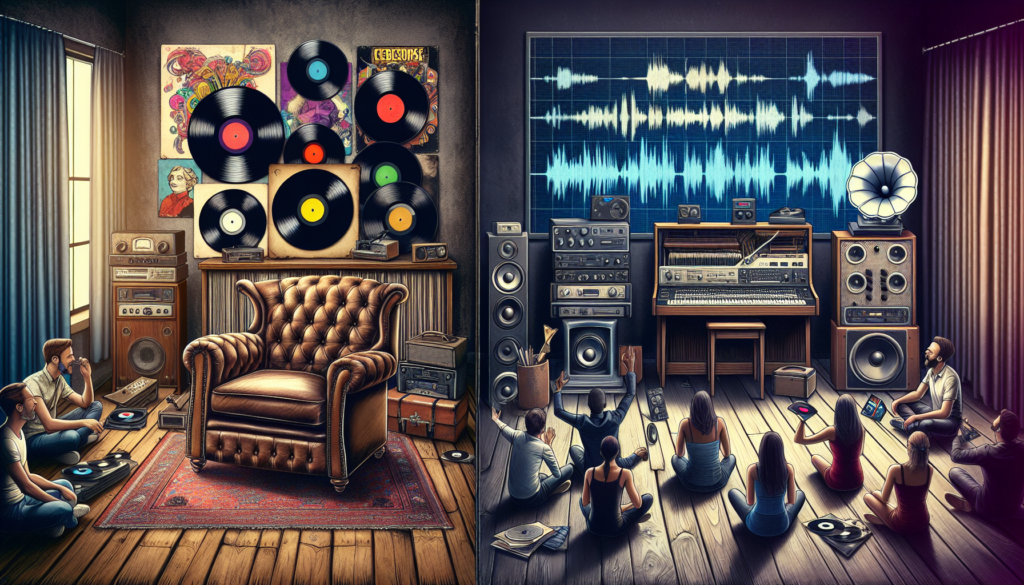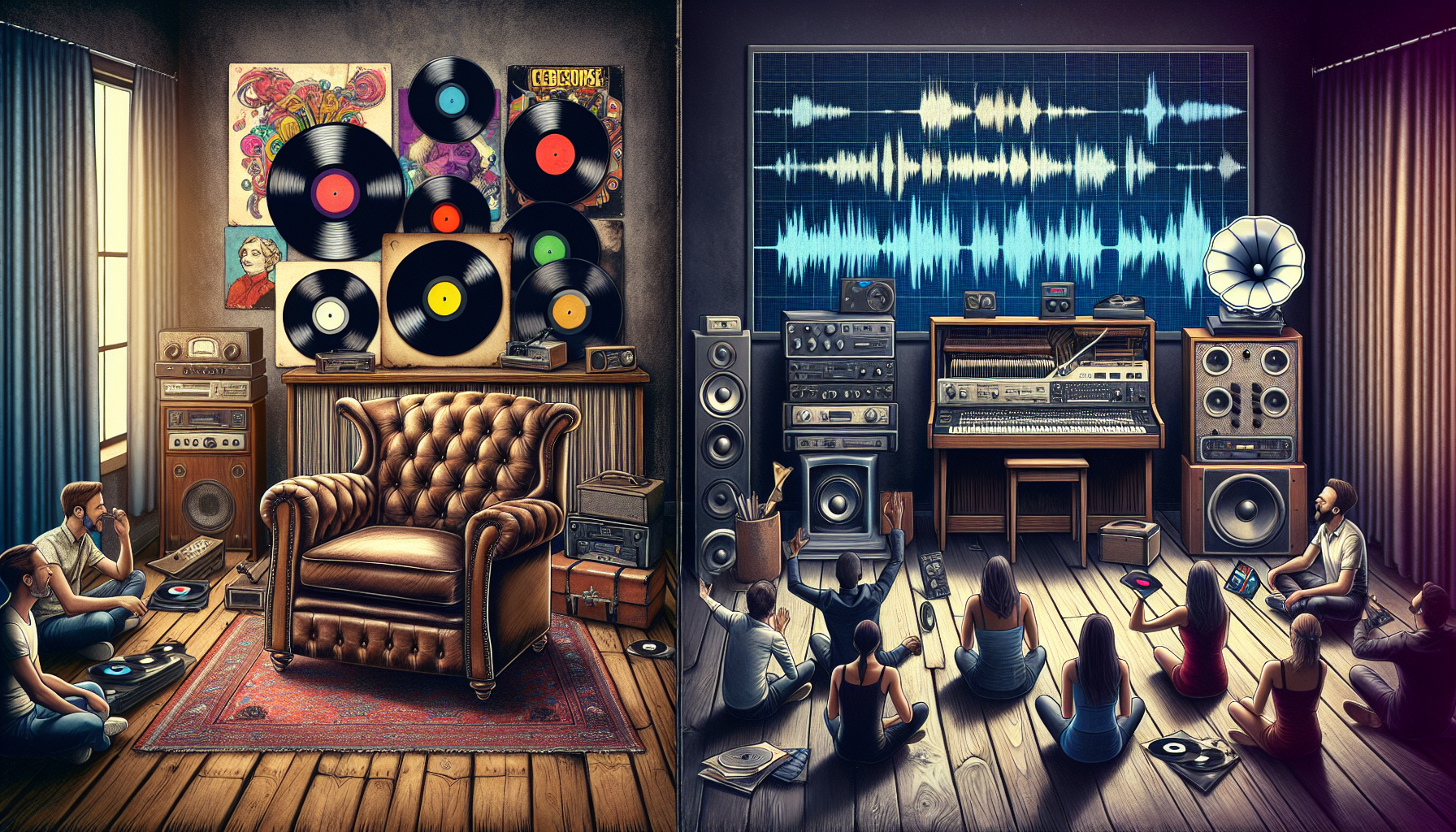Are you a music lover torn between the classic warmth of vinyl and the convenience of digital music? The age-old debate of what medium provides the best sound quality continues to ignite discussions among audiophiles. While vinyl enthusiasts argue that nothing can compare to the rich and authentic sound of a record spinning on a turntable, digital supporters argue that advancements in technology have allowed for crystal-clear audio reproduction. In this article, we will explore the age-old question: what has the best sound quality, vinyl or digital?

Vinyl Sound Quality
When it comes to sound quality, the debate between vinyl and digital audio has been a topic of discussion among audiophiles for years. Each format possesses its own unique characteristics and advantages, and it ultimately boils down to personal preference. In this comprehensive article, we will explore the various factors that contribute to the sound quality of vinyl records and digital audio, as well as the advantages and disadvantages of each format.
Analog vs. Digital
The fundamental difference between vinyl and digital audio lies in the way the sound is stored and reproduced. Vinyl records store sound in an analog format, where physical grooves on the record contain the audio waveform. On the other hand, digital audio consists of binary data that represents the sound waves in a series of 0s and 1s. This distinction in storage and reproduction methods gives each format its unique sonic characteristics.
Warmth and Depth
One of the aspects often associated with vinyl sound quality is the warmth and depth it offers. Vinyl records are praised for their ability to reproduce a rich, organic sound that adds a certain “warmth” to the music. This warmth is attributed to the inherent imperfections of the analog recording and playback process, which can sometimes result in subtle variations and harmonics that digital audio may lack. These imperfections give vinyl a unique charm and character that many enthusiasts appreciate.
Dynamic Range
Dynamic range refers to the difference between the quietest and loudest parts of a recording. Vinyl records generally have a superior dynamic range compared to digital audio, allowing for a wider range of tonal and volume variations. This increased dynamic range can result in a more immersive listening experience, as it enables the listener to better perceive the subtle nuances and delicate details of the music.
Mastering
The mastering process plays a crucial role in shaping the final sound quality of both vinyl and digital audio. Vinyl mastering requires specialized techniques to ensure compatibility with the medium’s limitations, such as controlling for inter-groove distortion and optimizing the frequency response. Digital mastering, on the other hand, focuses on maximizing the audio quality for digital distribution, often involving additional compression and equalization. Each format presents its own unique challenges and considerations in the mastering process, which can impact the final sound quality.
Surface Noise and Distortion
One downside of vinyl records is the presence of surface noise and distortion, which can arise from imperfections in the record itself or from the playback equipment. While some enthusiasts appreciate the nostalgic crackling of vinyl, others may find it distracting or detracting from the overall listening experience. Surface noise and distortion can affect the clarity and fidelity of the audio, especially during quieter passages or in the presence of background noise.
Playback Equipment
The quality of the playback equipment used also significantly influences the sound quality of vinyl. A high-quality turntable, cartridge, and speaker setup can greatly enhance the sonic performance, allowing for accurate tracking, precise reproduction, and minimizing unwanted artifacts. Investing in quality playback equipment is essential for extracting the full potential of vinyl sound.
Digital Sound Quality
With the rise of digital audio formats, such as CDs and streaming services, digital sound quality has come under scrutiny. While vinyl enthusiasts may argue that digital audio lacks the warmth and depth of analog, digital audio has its own set of advantages and considerations.
Bitrate and Compression
Digital audio is typically stored and distributed in compressed formats, such as MP3 or AAC. These formats employ compression algorithms that discard certain elements of the audio file deemed less important, reducing the file size. This compression can result in a loss of audio quality, particularly in terms of subtle details and transient response. However, lossless formats like FLAC and WAV offer higher bitrate options, preserving more of the original audio fidelity.
Frequency Response
Digital audio generally offers a wider frequency response compared to vinyl, ensuring that the highest and lowest frequencies are accurately reproduced. This extended frequency response can be particularly beneficial for genres of music that rely on deep bass or high-frequency details. The precision and accuracy of digital sound reproduction allow for a more faithful rendering of the original recording.
Dynamic Range
Similar to vinyl, digital audio can exhibit a wide dynamic range, capturing the full range of volume variations in a recording. However, some digital audio formats, especially those with high compression, may suffer from a reduced dynamic range due to data limitations. Nonetheless, advancements in digital technology have made it possible to achieve exceptional dynamic range in well-mastered digital albums.
Mastering
As mentioned earlier, mastering plays a critical role in the final sound quality of digital audio. While vinyl mastering often focuses on compatibility and limitations specific to the medium, digital mastering aims to optimize the audio for digital distribution and consumption. The approach to mastering can vary depending on the preferred playback platform, whether it be through headphones, speakers, or other digital devices.
Playback Equipment
The quality of the playback equipment used for digital audio can also significantly impact the sound quality. The choice of headphones, speakers, digital-to-analog converters (DACs), and amplifiers can all influence the overall listening experience. Investing in high-quality digital playback equipment is crucial for ensuring optimal sound reproduction and fidelity.
Comparison Factors
When evaluating the sound quality of vinyl and digital audio, several factors come into play that can influence the overall listening experience. It is important to consider these factors when assessing the merits of each format.
Quality of Source Material
Regardless of the format, the quality of the source material, such as the recording and mastering, ultimately determines the fidelity and sound quality. A poorly recorded or mastered album will not sound significantly better on vinyl than it would in a digital format. Conversely, a well-recorded and mastered album can shine on both vinyl and digital platforms.
Playback Equipment
Both vinyl and digital audio rely on playback equipment to reproduce the sound. The quality and condition of the equipment, including turntables, cartridges, speakers, and amplifiers, greatly impact the audio quality. It is crucial to invest in high-quality playback equipment and regularly maintain it to ensure optimal sound reproduction.
Listening Environment
The listening environment can significantly affect the perception of sound quality. Factors such as room acoustics, ambient noise, and speaker placement can all influence the overall listening experience. Taking steps to optimize the listening environment can enhance the sound quality of both vinyl and digital audio.
Listener Preferences
Ultimately, personal preference plays a significant role in determining which format offers the best sound quality. Some listeners may prefer the warmth and character of vinyl, appreciating its unique sonic attributes and nostalgic appeal. Others may value the convenience and precision of digital audio, enjoying the ability to easily access and stream their favorite music. It is important to consider individual taste and preferences when assessing the sound quality of each format.
Advantages of Vinyl Sound
While vinyl may have its limitations, it also possesses several advantages that make it a beloved format among audiophiles and music enthusiasts.
Analog Sound
Vinyl records offer an analog sound that many listeners find particularly appealing. The inherent imperfections and characteristics of analog recordings often result in a more organic and natural sound that can be perceived as more authentic and pleasing to the ear.
Warmth and Depth
The warmth and depth of vinyl sound are highly regarded by many music lovers. The subtle variations, harmonics, and tonal qualities introduced by the vinyl playback process can create a more immersive and emotionally engaging listening experience.
Physical Interaction
Playing vinyl records involves a physical interaction with the medium, which adds to the overall experience. The act of carefully handling the record, placing it on the turntable, and delicately lowering the needle can be seen as a ritualistic and nostalgic process that enhances the connection between the listener and the music.
Collector’s Appeal
Vinyl records hold a unique collector’s appeal that many enthusiasts find irresistible. The large album artwork, insert materials, and limited edition releases contribute to the visual and tactile experience of owning vinyl records. For collectors, the physicality and tangible nature of vinyl add value and sentimentality to the music.
Advantages of Digital Sound
Digital audio formats offer their own set of advantages that have contributed to their widespread adoption and popularity in recent years.
Consistency
Digital audio formats, particularly lossless ones, provide consistent sound quality with each playback. Unlike vinyl, where variations in pressing, manufacturing, and condition can impact the sound, digital audio ensures a consistent listening experience that can be replicated across different devices and platforms.
Ease of Use
Digital audio is highly convenient and user-friendly. With the advent of streaming services and digital downloads, music can be accessed instantly and effortlessly. The ease of creating playlists, accessing vast libraries, and seamlessly switching between tracks make digital audio a preferred choice for many listeners.
Portability
The portability of digital audio is a significant advantage in the modern era. With smartphones, portable media players, and wireless headphones, music can be enjoyed on the go without the need for physical media. This level of convenience and accessibility has revolutionized the way we consume music.
Digital Enhancements
Digital audio offers the possibility of post-production enhancements and adjustments that can enhance the listening experience. These enhancements include equalization, sound effects, and spatial audio technologies, which allow for a more personalized and immersive listening experience.
Disadvantages of Vinyl Sound
While vinyl has its unique charms, it also comes with some disadvantages that may deter certain listeners.
Limited Frequency Response
Vinyl records have inherent limitations when it comes to frequency response. The physical nature of the record groove restricts the ability to accurately reproduce extremely high or low-frequency sounds. This limitation can result in a loss of detail and fidelity, particularly in the reproduction of complex musical passages.
Surface Noise and Distortion
Vinyl records are susceptible to surface noise and distortion, which can arise from imperfections in the record itself or from the playback equipment. Surface noise, such as crackles and pops, can be distracting and diminish the overall listening experience. Additionally, distortion caused by improper tracking, worn-out stylus, or subpar turntable setup can affect the clarity and accuracy of the audio.
Prone to Damage and Wear
Vinyl records are fragile and susceptible to damage and wear. Mishandling, improper storage, and environmental factors such as heat and humidity can degrade the sound quality over time. Additionally, repeated playback can result in gradual degradation of the record’s grooves, leading to a loss of fidelity and introducing unwanted noise.
Disadvantages of Digital Sound
While digital audio offers several advantages, it also has its own set of disadvantages that may impact the sound quality and overall listening experience.
Compression Artifacts
Lossy compression formats, such as MP3, introduce artifacts that can degrade the audio quality. These artifacts manifest as audio distortions, particularly in transient response and subtle nuances. Although lossless formats mitigate this issue to some extent, highly compressed digital audio can still suffer from undesirable artifacts.
Harshness and Sterility
Digital audio can sometimes be criticized for its perceived harshness and sterility. The precision and accuracy of digital reproduction can lead to a more clinical and less organic sound, particularly for listeners who prefer the warmth and imperfections associated with analog sound.
Lack of Tangibility
For some audiophiles and music enthusiasts, the intangible nature of digital audio can be seen as a disadvantage. Unlike vinyl, which involves a physical connection and interaction with the medium, digital audio lacks the tactile experience and tangible presence that some listeners find appealing.
Conclusion
In the end, the debate between vinyl sound quality and digital sound quality is subjective and dependent on personal preference. Both formats have their own unique characteristics and advantages, making it difficult to declare one as definitively superior to the other. Vinyl offers a distinct analog sound, warmth, and physical interaction that appeal to many, highlighting the unique charm of the format. On the other hand, digital audio provides consistency, ease of use, portability, and the possibility of digital enhancements, catering to the needs of modern listeners. Ultimately, the choice between vinyl and digital comes down to individual taste, listening habits, and priorities. The important thing is to enjoy the music in whichever format brings the most joy and satisfaction.

